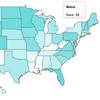Going green | A new $48M border station in Calais should ease congestion and enhance commerce
Long-distance truckers like Donald Newman and his team of drivers often have to add more than two hours to their estimated travel time to account for delays at the Calais international border crossing. Newman owns D.L. Newman trucking in Alexander, a long-distance trucking company that transports seafood across the border daily from New Brunswick to Portland, Boston and New York. In recent years, an increase in traffic and heightened regulation at the border has made the process of daily crossings a nightmare, especially in the summer, says Newman. This fall, Newman and his crew of 12 drivers are looking forward to a more productive use of their time on the road when a new international bridge and land port of entry facility opens in November.
For Maine’s poorest county, the construction of the new bridge in Calais — the country’s first new bridge into Canada in more than 30 years — stands out as a bright light during bleak economic times. Backers of the Calais project are hopeful easier crossings between Maine and New Brunswick will make doing business Down East more efficient.
Occupying a 54-acre parcel at the western edge of Calais, the bridge, built by Pittsfield-based Cianbro, and the accompanying 100,000-square-foot port-of-entry facility of are set to open in November. The opening is the culmination of more than nine years of collaborative planning between the U.S. General Services Administration, Maine and New Brunswick departments of transportation and many other agencies. The $48.3 million border station, being built for the Department of Homeland Security and Customs and Border Protection, will facilitate cross-border traffic at one of the country’s busiest commercial crossing points by separating commercial and passenger traffic. The crossing at Calais is a key gateway from Maine and the U.S. market to four Atlantic Provinces in Canada, facilitating the export of more than $8 million in goods in 2007 according to the U.S. Bureau of the Census, Foreign Trade Division.
Today, the primary commercial border crossing in eastern Maine at Ferry Point sits beside the Saint Croix River in the heart of downtown Calais and St. Stephen, N.B. Designed in the 1930s, the Ferry Point crossing serves commercial and passenger traffic with a single travel lane, comingling vacationers and shoppers with commercial vehicles carrying anything from seafood to hazardous materials like uranium. The current crossing is not equipped for the quantity of traffic that crosses the border each day, according to Tim Donnell, assistant port director in Calais. “It is not uncommon to have four- to five-hour waits.”
Long waits and heavy traffic were not always the status quo at Ferry Point. For residents of Calais and St. Stephen, the border between their two towns had for years been seen as little more than a municipal boundary. They were neighboring communities, with mutual aid for fire calls and a lot of common friends and relatives. Then two events changed the ease of passage. In 1988, Canada and the United States adopted a free trade agreement. “Very quickly, truck traffic coming into the United States doubled from about 60,000 trucks coming into the United States to about 120,000 trucks [a year],” says Kevin Rousseau, transportation planning specialist with the Maine DOT.
Thirteen years later, the September 11, 2001 attacks changed the crossing even more, bringing in stricter security requirements mandated by the U.S. Department of Homeland Security.
Planning for a new bridge that would relieve border congestion began in December of 1999 and was a joint effort of more than 59 federal, provincial, state, international and local agencies from the U.S. and Canada. Rousseau describes the planning and construction of the gigantic project as a four-person waltz. “You have the highway infrastructure on one side, the highway infrastructure on the other side, the border station on one side and the border station on the other, and all the funding, all the planning, all the permitting had to be coordinated.”
A design for Maine
New York’s Robert Siegel Architects was selected by the GSA to create a gateway to the U.S. in Calais that could address the variety of needs identified in the preceding five years. In 2007, Siegel’s design received a prestigious award from the American Institute of Architects New York chapter; the first border station ever to win this award. “This border station is a case study in how you can integrate security processes with a major piece of civic architecture,” says Siegel. At once, the building must be welcoming, but secure, and open, but closed.
Inspired by Maine’s rugged landscape, the building’s exterior is designed to resonate with its surroundings. The 100,000-square-foot facility will be wrapped with a textured aluminum façade, which serves as both a barrier to surveillance and a means of blending into the surrounding environment by reflecting seasonal color changes in the sky and landscape.
The border station separates commercial inspection from passenger traffic, offering a full nine lanes for inbound inspection, and its approaching roadways are designed with projected commercial truck traffic increases in mind. Ernie Martin, project manager for Maine DOT, says truck traffic is anticipated to increase from 7% of total traffic volumes in 1999 to 12.2% in 2030, and the bridge is designed to accommodate those increases and more.
The commercial side of the facility includes refrigeration units for the large quantities of seafood that pass through Calais on the way to Portland, Boston and New York’s fish markets.
Bridge economy
The bridge project has kept Calais residents and businesspeople busy since its planning began. The project employed area contractors like Calais-based Mingo Construction and Dicenzo Inc., which operated machinery and provided the manpower for highway projects associated with the new bridge. “This area has a lot of local talent,” says Siegel. “At the beginning of the job there were a lot of guys coming to the trailer saying, ‘Hey, is there work?’ and from that, there was a very hard-working crew.”
For the city, the bridge is regarded as both a blessing and a challenge. Once the construction is complete, the bridge might divert passenger traffic from downtown Calais, a challenge Assistant City Manager Jim Porter says is one of the hurdles that the city will have to address. “Both Calais and St. Stephen feel that we want as much of the passenger traffic to use the existing Ferry Point bridge as possible,” says Porter. “If we could have made [the new bridge] just a commercial truck traffic bridge, we would have done that. But that wasn’t acceptable because when you have federal highway’s money in a project, all forms of transportation have to be able to utilize it.”
The major opportunity for economic growth in Calais is downtown, where stores like Marden’s, Shop ‘n Save and other small shops serve a clientele from around Washington County and Charlotte County, N.B. Porter hopes that alleviating heavy truck traffic downtown will encourage more shoppers to make the trip from Canada. But, shoppers might not bother making the visit if the Canadian dollar is low. Downtown retailers are most successful when the Canadian dollar is high, says Porter, noting that it has fallen to below 80 cents.
Porter is cautiously hopeful that there are opportunities for economic growth in the Calais Industrial Park that lies adjacent to the new bridge. “There may be transportation-related opportunities for a freight company to break down shipments either entering the country or leaving the country.” The town lost property taxes when MDOT acquired properties for the project through eminent domain. Growth in the industrial park could balance out those losses, says Porter.
“You can’t underestimate what kind of improvement the new bridge is going to have to the flow of transportation for Canada’s Atlantic Provinces,” says Rousseau. While officials won’t guess how much more business the new bridge will generate between Maine and New Brunswick, Rousseau says the new facility offers an infinite capacity for increased traffic compared with the current operation.
One thing this bridge will guarantee is a faster and more cost-effective drive for long-distance truckers like Donald Newman, who already cross in Calais daily. For the time being, Newman says, his customers will probably stay the same. “Most likely, we’ll have the same amount of customers and business, but it will take us less time and the drivers will have more productive time.”
Rebecca Lazure, a writer based in Lewiston, can be reached at editorial@mainebiz.biz.










Comments